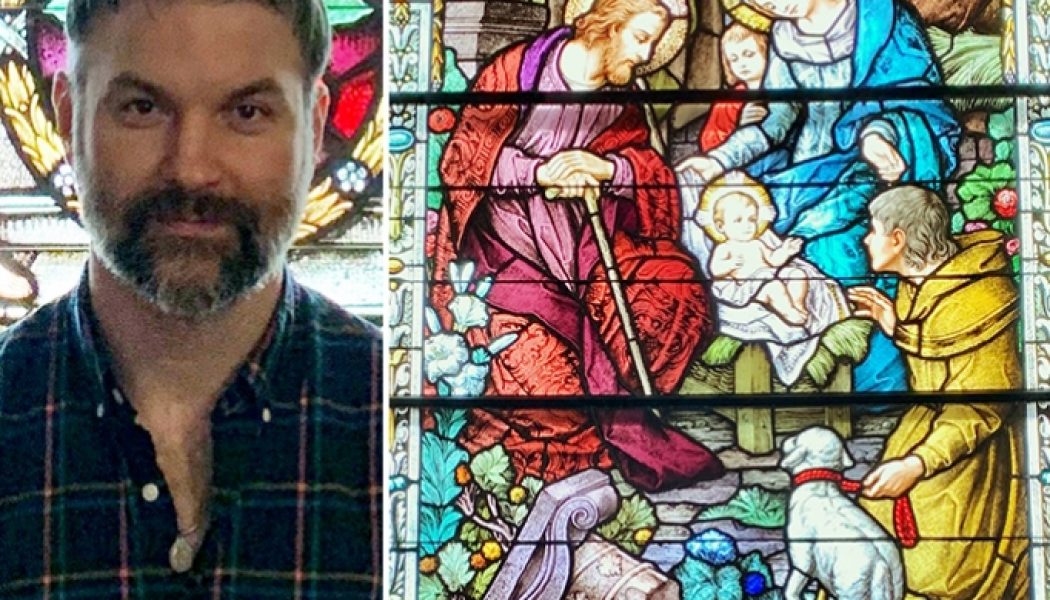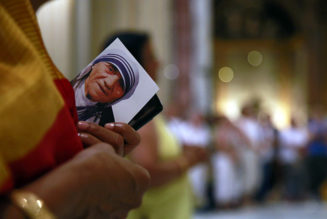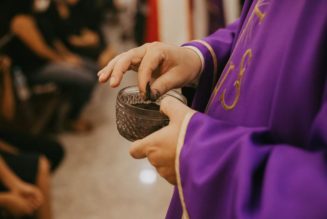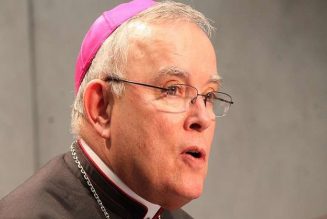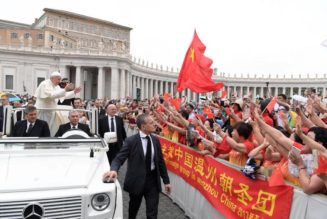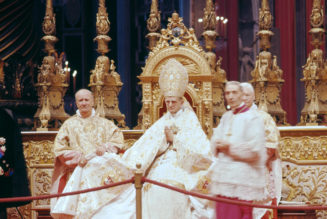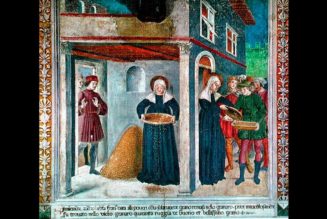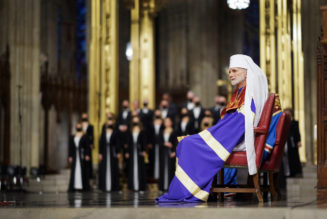
John Scott stands in front of a large stained-glass window at historic Holy Rosary Church in Cedar, Michigan. The right half of the image shows more of the same window. (Courtesy of John Scott)
Of all the great players who competed in the 2016 NHL All-Star Game, John Scott was named the most valuable. This would have been quite an honor for any player, but especially for one who was not even supposed to be there.
The Edmonton, Alberta-born defenseman/winger was the subject of a campaign to get someone on the all-star roster who would not normally be there. League administrators did not like the idea and attempted to prevent Scott from participating. However, the desire of fans — and Scott’s own solid play — won out.
While Scott’s All-Star MVP status came as a surprise, the next four years would bring another event many fans would not expect. At 6 feet, 8 inches tall and 260 pounds, Scott had become known as one of the roughest guys in pro hockey. Fights were not uncommon in his decade-long pro career that included stints with the New York Rangers, Minnesota Wild, Chicago Blackhawks, Buffalo Sabres, San Jose Sharks, Arizona Coyotes and Montreal Canadiens.
Over the years, fighting lost its appeal to the 37-year-old Scott, who, at the same time, was being drawn closer to the Catholic Church. The father of six — five born and one due this summer — was baptized in 2017 and now attends the traditional Latin Mass at Holy Rosary Church in the Diocese of Gaylord, Michigan.
Scott summarized his extraordinary story — which also includes a podcast, book and preparation for filming a movie — at a time that, under normal circumstances, would have seen the NHL Stanley Cup Playoffs underway.
Since you’re so tall, I assume you played basketball as well as hockey.
Well, people assume that, but it’s not really the case. I did play basketball in grade 5 but hated it, so I kept on playing hockey — which is almost an automatic in Canada — along with baseball, volleyball and lacrosse. Even without a stick and a puck, I just enjoyed being on the ice. I would skate for miles and miles and just felt very much in the right place.
Add the stick, puck, pads and teammates to the mix, and that’s how I spent almost 30 years of my life. I got to play hockey with the same group of kids from about age 6 to 16. That gave me the opportunity, not only to learn a sport, but to learn how to interact with others productively. It wasn’t just a physical skills thing, but a social skills thing, so I learned a lot from hockey.
I’m grateful my parents kept me in the sport, despite the expenses. All the equipment and travel really added up over the years, so when I got a scholarship to Michigan Tech, we were able to say it was worth it financially.
How did the All-Star Game appearance come about?
Some bloggers and podcasters in Canada got the idea in the 2015-16 season that it would be fun to vote someone into the All-Star Game who would not normally be there. I ended up being the man they wanted for that, so lots of fans voted for me.
However, the league did not want me to be at the game, not only because I had a penchant for punching, but because they thought I would be too slow for the new three-on-three format they had come up with. I was even traded in the hope that the transition from one team to another would lessen the number of votes I got. Despite the league’s efforts, I was voted in, named the Pacific Division’s captain, played well, and was even named the MVP.
It was a surreal thing, and I ended up telling the story in my autobiography, A Guy Like Me: Fighting to Make the Cut. A movie will be made about the All-Star Game, too. Mitch Albom wrote the script, the casting is being done, and we are hoping to film this year.
Since your career included not only being tough but actual fights, how do you reconcile that with Catholicism?
I’ve been asked that a lot, and I’m not sure I have the right answer to the question, but here are some thoughts: I asked a priest about it, and he said that fighting is not inherently wrong. It shouldn’t be done as the first resort, but it can be done to defend oneself, rather than to simply inflict harm. Even though I have been in positions to really hurt opponents, I didn’t injure them on purpose.
Fighting in order to injure is not okay, and fighting for the sake of fighting is not okay, either. However, if it’s done in the context of achieving something in a rough sport, it’s not automatically wrong.
Fighting was a routine part of my career, and it was literally part of my job description. I was paid to protect my teammates, but I enjoyed not having to do it at the All-Star Game. Now that I’m retired from the sport, have five daughters, and am a practicing Catholic, I have even more appreciation for peacefully proceeding without punches.
You were not a cradle Catholic?
No, I was not a Catholic or anything else; I had no religious background at all. Hockey would have been the closest thing to religion for me, since it colored my whole outlook on life and I spent so much time on it.
When I started dating my wife, Danielle, in college, I thought about the possibility of becoming Catholic. She was a cradle Catholic, and her faith gave her something I didn’t have, which was a stable footing in life. I was skating on thin ice in some ways and didn’t have an overall explanation for how the world was put together or its ultimate meaning.
Danielle’s parents were in Traverse City, Michigan, which is easier to visit from Michigan Tech than St. Catharines, Ontario, where my parents were. I would sleep in the basement, she would sleep in her own room, and we would go to Mass with her parents.
After college we got married in the Church, and that made me really want to take the sacrament seriously. Danielle made it clear that if I wanted to get married, it would be in the Catholic Church and I had to agree to raise our children Catholic. We then met with a priest leading up to the wedding day and discussed the lifelong commitment to each other and the procreation and instruction of children.
Over the years I thought more of becoming Catholic, but hockey seemed to get in the way. I’d start an RCIA course, and then we’d have to move. I’d start another RCIA course, and then we’d have to move again. Finally, after my career ended four years ago, we were able to settle down, and I could really dive into the faith without reservations. Then I was baptized at the Easter vigil in 2017.
Did Danielle encourage you to become Catholic?
She did, but not in an overbearing way. She had a desire for me to come into the Church, but was content because I participated with her in the Mass to a large degree; the major exception being that I did not receive Holy Communion.
She gave me the room to make my own decision. That’s how I try to see my own efforts at sharing the faith now, which avoids either extreme of doing too much or not doing enough.
All Catholics are required to share the faith, but at the same time, allow each person to make his own decision. It’s not a matter of either-or, but both-and. Offer the greatness of the faith and let people use their free will for accepting or rejecting it. That’s what God does with us.
Is it challenging to have a larger family than most modern Americans are accustomed to?
It is unusual statistically, yet the important thing is not to be average, but to live how the Church teaches us to live, by being open to life. There are probably challenges larger families face that smaller ones don’t have, but there are benefits, too.
With larger families there are built-in friends and opportunities for self-denial and expanding one’s horizons. There’s always something to learn about, and the major lesson that there’s more to life than you is learned more easily in larger families.
Even though we have what is considered a large family today, we were missing a sense of a broader community, since we home-school our five daughters. We did not have a schoolhouse to go to, so we sought out a local parish that we knew had an abundance of large families like ours.
That parish was Holy Rosary in tiny Cedar, Michigan — known far and wide for its classic Gothic-style stained-glass windows. The parish was founded in a small immigrant Polish community and is still surrounded by rolling farm country on all sides. It has beautifully reverent ordinary and extraordinary forms of the Mass and provides a rich wellspring of catechesis for our family.
Holy Rosary is off the beaten path compared to other Catholic churches in the area, but it’s well worth the drive. We love how strong the parish family is, the care we get from our pastor and his associate and the devotion to the true teachings of our faith.
Is that parish run by the Priestly Fraternity of St. Peter — which counts former pro baseball player Father Michael Cunningham and former opera singer Father Michael Magiera among its priests?
We are familiar with the fraternity, but our parish is a regular diocesan parish with a priest appointed by the bishop. We are blessed to have such a knowledgeable pastor who has a deep appreciation and zeal for our faith.
We are fortunate to attend a solemn high Mass every Sunday. It’s so cool to be a part of how organized it is, the precision of the servers, the incense, the heavenly music and the language used. I’m even learning more Latin in order to serve at the altar myself.
We also have a beautiful perpetual adoration chapel, which is a large feat considering how small our parish is. I look forward to my weekly Eucharistic adoration hour, which is a much-valued time to be in the direct presence of God. There’s a sense of peace that prevails in that hour, and I think it helps me to live the rest of the day and week better. You put in time and get more quality time out of it.
Do you pray the Rosary or Divine Mercy Chaplet?
We all have our individual devotions; my wife is faithful to the chaplet, but together as a family we pray a daily Rosary, which is the most important thing we can all do together right now.
Our home is enthroned to the Sacred Heart of Jesus and the Immaculate Heart of Mary, so we renew that consecration monthly with the First Friday and First Saturday devotions. We pray the Morning Offering and the Angelus and attend weekday Mass when we can.
This gives us a sense of structure and is a reminder of our need to ask for help in order to overcome the temptations of the world and do God’s will. Mary did God’s will perfectly, as the best mother anyone could ask for, so getting her to help us do God’s will better makes perfect sense.
What also makes perfect sense, especially for us men, is to learn more about St. Joseph and rely on his help. St. Joseph is the model for all Christian husbands and fathers, and his lead is more important today than ever before. He named Jesus, saved him from Herod, and did everything else right, without any bragging. His silence was his strength.
I was blessed to go to our local Catholic Men’s conference a year ago and hear Father Donald Calloway talk very enthusiastically. I’ve been reading his new book, Consecration to St. Joseph, and learning more about the amazing man who led and protected the Holy Family.
Other than Nick Foligno and Ken Kal, there doesn’t seem to be a lot of Catholicism in the NHL.
The NHL has a lot of Canadians and Scandinavians, which are areas that aren’t very religious. It’s not surprising, then, that the NHL would not be very religious either. I did see some Protestants, but very few Catholics.
Actually, some of the players probably were Catholic without me knowing it. It’s sad, but I think they might be intimidated by the culture at large or by the idea that they have to know everything about Catholicism perfectly before sharing any of it.
This is the time when we need to hear more about the greatness of Catholicism, which offers an alternative to what we hear and see so much of today. The happiness of the world is so superficial, but the happiness of Catholicism is so deep.
Being trained in engineering, I like to get all the facts and see how they fit together. I read the Bible and Catechism, of course, and other books I’ve read recently include Jesse Romero’s The Devil in the City of Angels and Scott Hahn’s Signs of Life. These, and so many other books, show how being part of the Catholic Church is “where it’s at.”
Now that you’re “skating on thick ice,” what would you say to other hockey players and men in general about the Church?
If you want to be truly fulfilled as a man, the Catholic Church is where that will happen. This can be learned through the study of all kinds of resources, but it’s important, during all the inquiry, to pray for the grace to live out what is found.
Jesus wants to transform us into himself in order to be worthy of heaven. That’s something no amount of study alone can accomplish; grace makes it possible, and grace is found in unique ways in prayer and the sacraments.
The way I see things now that I’m a baptized Catholic is so much clearer and more hope-filled. When I played hockey, it was almost everything to me. Making the roster was nearly a matter of life and death. Now I can see that hockey is a game that should be enjoyed and not taken so seriously.
That relates to the name of my podcast, which is The Fight That Matters. We have all kinds of battles in life, but few of them really mean anything in the long run. The one that will have, not only long-lasting effects, but everlasting ones, is the fight for salvation. That’s what it all comes down to, really: ensuring that we win heaven.
Aside from your podcast, have you done any speaking in person?
I’ve done some speaking in Canada, but it’s almost all been done locally here in Michigan schools. I wanted to do some more speaking, so contacted Ray McKenna from Catholic Athletes for Christ about that. Then assembles and other large events suddenly became nonexistent, but I still hope to speak more in the future.
People are drawn by the unlikely All-Star Game story, but there’s so much more to my life now that I get to share. It makes me think maybe I should put out another book, because a lot has happened in the past three-plus years since the first one was released. There are many possible avenues for sharing the faith, but all of them are motivated by my desire to help others find their way to heaven. That is the fight that matters.
Register correspondent Trent Beattie writes from Seattle.
His book Fit for Heaven (Dynamic Catholic, 2015)
contains numerous Catholic sports interviews,
most of which have appeared in the Register.
His latest book is Apostolic Athletes.
This story was updated after posting.
